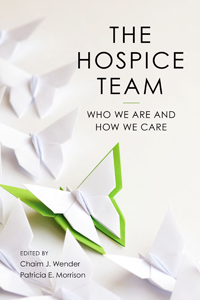 Reading Room Reading Room
The Hospice Team: Who We Are and How We Care
Edited by Rabbi Chaim Joseph Wender, DMin, F.LBC, and Patricia Ellen Morrison, LCSW
Health Professions Press, 2019
What is hospice? This book provides the answer in a way that is both accessible and insightful. The Hospice Team is an edited book that describes the delivery of hospice care from the perspective of 21 providers in professions that typically compose a hospice care team. Each author contributes something unique to this discussion, that mirrors real life, where the strength of an interdisciplinary team is diversity in perspective and approach. Likewise, the presentation style and voice vary across this book, which allows for more opportunities for the reader to connect with similar content explained in different ways.
The structure of each chapter and shared focus on hospice care lends continuity to the book. Each chapter focuses on why the author chose to work in hospice care. They describe their professional responsibilities on the hospice care team. The authors also share how it feels to be a provider of hospice care, including memorable stories about working with patients. In essence, The Hospice Team demystifies the delivery of hospice care and humanizes the providers in the process. This is important, as candid discussion about hospice care can be a comfort during a potentially fearful time for patients and their families.
For example, the book demonstrates how the purpose of hospice care is to support quality of life. This involves good palliative care to manage uncomfortable symptoms that can lead to biopsychosocial and spiritual/existential suffering. One thing that is particularly striking are the personal and, even, spiritual reflections that the contributors share about their experiences. This includes how some authors dealt with their own grief, reflected critically about how they might have better supported their patients, and experienced difficulty in finding opportunities to fully employ their professional skills.
The Hospice Team clarifies what each provider offers and instills confidence in the therapeutic power of the hospice team. It is a good book for any person, including social workers, who are unfamiliar with hospice care or want to learn more. This book may be used by social work educators with undergraduate and graduate students to gain insight as future hospice care providers. Social work practitioners may share this book with clients who need more information about receiving hospice care. The book is well written, relatively short, and available in a digital format.
— Ann M. Callahan, PHD, LCSW, Eastern Kentucky University
|